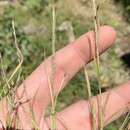Comprehensive Description
provided by North American Flora
Muhlenbergia sylvatica Torr. ; Trin. Mem. Acad. St.-Petersb
VI. 6-: 292 (reprint 46). 1841.
/Igi-Oi/JS (/i^Msa Muhl. Descr. Gram. 64. 1817. (Type from Pennsylvania.) Hoi A. difusa Host.
1809. Agrostis sylvalica Torr. Fl. U. S. 1: 87. 1823. (Basis of Muhlenbergia sylvalica Torr.) Not A.
sylvatica L. 1762. Muhlenbergia sylvalica var. gracilis Scribn. Trans. Kansas Acad. 9; 1 16. 1885. (Type from Topeka,
Kansas.) Muhlenbergia umbrosa Scribn. Rhodora 9: 20. 1907. (Based on Agroslis sylvalica Torr.) Muhlenbergia umbrosa var. aUenuata Scribn. Rhodora 9: 21. 1907. (Type from Aurora County,
.South Dakota, Wilcox 25; awn reduced or wanting.) Muhlenbergia diffusa Farwell, Rep. Mich. Acad. 20: 16S. 1918. (Based on Agroslis diffusa Muhl.)
Not M. diffusa WWW. 1797. Muhlenbergia umbrosa f. atlenuata Deara, Grasses Ind. 171. 1929. (Based on M. umbrosa var.
aUenuata Scribn.)
Perennial, with creeping scaly rhizomes, resembling M. mexicana in habit, freely branching, the branches more slender and lax ; culms retrorsely scabrous below the nodes ; sheaths glabrous ; ligule about 0.5 mm. long; panicles slender, nodding, 5-15 cm. long, the branches distant, appressed, overlapping or the lower scarcely so; glumes lanceolate, rather abruptly acuminate or awn-pointed, about 2 mm. long; lemma a little longer than the glumes, somewhat pilose below, tapering into an awn 5-10 mm. long. Awn sometimes reduced or wanting.
Type locality: MountaiHs of New Jersey.
Distribution: Moist woods and thickets, Maine to South Dakota, and southward to Alabama and Texas; Arizona.
- bibliographic citation
- Albert Spear Hitchcock. 1935. (POALES); POACEAE (pars). North American flora. vol 17(6). New York Botanical Garden, New York, NY
Physical Description
provided by USDA PLANTS text
Perennials, Terrestrial, not aquatic, Rhizomes present, Rhizome elongate, creeping, stems distant, Stems trailing, spreading or prostrate, Stems nodes swollen or brittle, Stems geniculate, decumbent, or lax, sometimes rooting at nodes, Stems caespitose, tufted, or clustered, Stems terete, round in cross section, or polygonal, Stems branching above base or distally at nodes, Stem internodes hollow, Stems with inflorescence less than 1 m tall, Stems, culms, or scapes exceeding basal leaves, Leaves mostly cauline, Leaves conspicuously 2-ranked, distichous, Leaves sheathing at base, Leaf sheath mostly open, or loose, Leaf sheath smooth, glabrous, Leaf sheath and blade differentiated, Leaf blades linear, Leaf blades 2-10 mm wide, Leaf blades mostly flat, Leaf blades mostly glabrous, Ligule present, Ligule an unfringed eciliate membrane, Inflorescence terminal, Inflorescence a contracted panicle, narrowly paniculate, branches appressed or ascending, Inflorescence a dense slender spike-like panicle or raceme, branches contracted, Inflorescence solitary, with 1 spike, fascicle, glomerule, head, or cluster per stem or culm, Inflorescence branches more than 10 to numerous, Flowers bisexual, Spikelets pedicellate, Spikelets laterally compressed, Spikelet less than 3 mm wide, Spikelets with 1 fertile floret, Spikelets solitary at rachis nodes, Spikelets all alike and fertille, Spikelets bisexual, Spikelets disarticulating above the glumes, glumes persistent, Spikelets disarticulating beneath or bet ween the florets, Rachilla or pedicel glabrous, Glumes present, empty bracts, Glumes 2 clearly present, Glumes equal or subequal, Glumes shorter than adjacent lemma, Glumes 1 nerved, Lemmas thin, chartaceous, hyaline, cartilaginous, or membranous, Lemma similar in texture to glumes, Lemma 3 nerved, Lemma glabrous, Lemma apex acute or acuminate, Lemma distinctly awned, more than 2-3 mm, Lemma with 1 awn, Lemma awn less than 1 cm long, Lemma awn 1-2 cm long, Lemma awned from tip, Lemma awns straight or curved to base, Lemma margins thin, lying flat, Lemma straight, Callus or base of lemma evidently hairy, Callus hairs shorter than lemma, Palea present, well developed, Palea membranous, hyaline, Palea about equal to lemma, Palea 2 nerved or 2 keeled, Stamens 3, Styles 2-fid, deeply 2-branched, Stigmas 2, Fruit - caryopsis, Caryopsis ellipsoid, longitudinally grooved, hilum long-linear.

